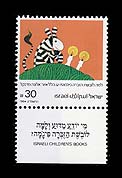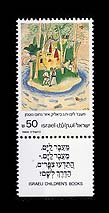|
|
Children's books - books written specially for children, are an integral part of the national literature of all cultures. They first appeared in western Europe in the 18th century and flourished in the 19th, encompassing all literary forms and subjects.
The first children's books in Hebrew appeared in the 19th century and were pedagogic in nature. The genre developed rapidly towards the end of the century, and by the beginning of the present century Eretz Israel had become the centre of activity where children's books were written by many people - some who wrote mainly for children, others who wrote also for children. Their authors included some of the outstanding representatives of the new generation of Hebrew writers.
Haim Nahman Bialik (1873-1934), the Hebrew national poet, began to write, translate and edit books for children at the beginning of the century. He wrote poems, songs and legends. Many of his poems which were set to music became classics and popular children's songs. His poem $$Across the Sea" was included in the collection of his children's poems issued to celebrate his 60th birthday.
The book "Children's Songs and Lyrics" was illustrated by Nahum Gutman (1898-1980). Gutman, who was one of the pioneers of painting in Eretz Israel, was at the same time
one of the first illustrators of Hebrew children's books and one of the most important authors of books for children and youth. His first and best-known book was "In the Land of Lobengulu, King of the Zulus" (1940) which was awarded the Israel Prize for children's literature in 1978. "Across the Sea" is the story of an imaginary land that the painter depicted as an oriental wonderland.
Leah Goldberg (1911-1970) Hebrew poet, translator of the classics and a noted literary researcher, also addressed much of her writing to the young reader. Her stories and poems, originally published in children's newspapers, became classics of Hebrew children's literature. Her adaptations of Russian children's stories are also well known. Her story "Apartment to Let" tells of a tower inhabited by different animals (a reference to the Israeli communal apartment block) the moral of which is the importance of good-neighbourliness and a willingness to see the positive and good side of every situation. The book was illustrated by Shemuel Katz (born 1926), one of the outstanding Israeli painters and illustrators of children's books.
O. Hillel (Hillel Omer, born 1926) a landscape gardener by profession, is a children's poet who introduced a free, modernistic line into children's literature, full of humour and unusual metaphors. His best known works are the stories of eccentric Uncle Simcha.
His humorous poem "Why is the Zebra Wearing Pyjamas" which first appeared in a book of that name published in 1961 was later reprinted in an anthology of his animal stories "Of Flies and Elephants" (1977) and illustrated by Alona Frankel, herself a well-known writer of short stories for children and one of the most important artist-illustrators of children's books in the last decade.



